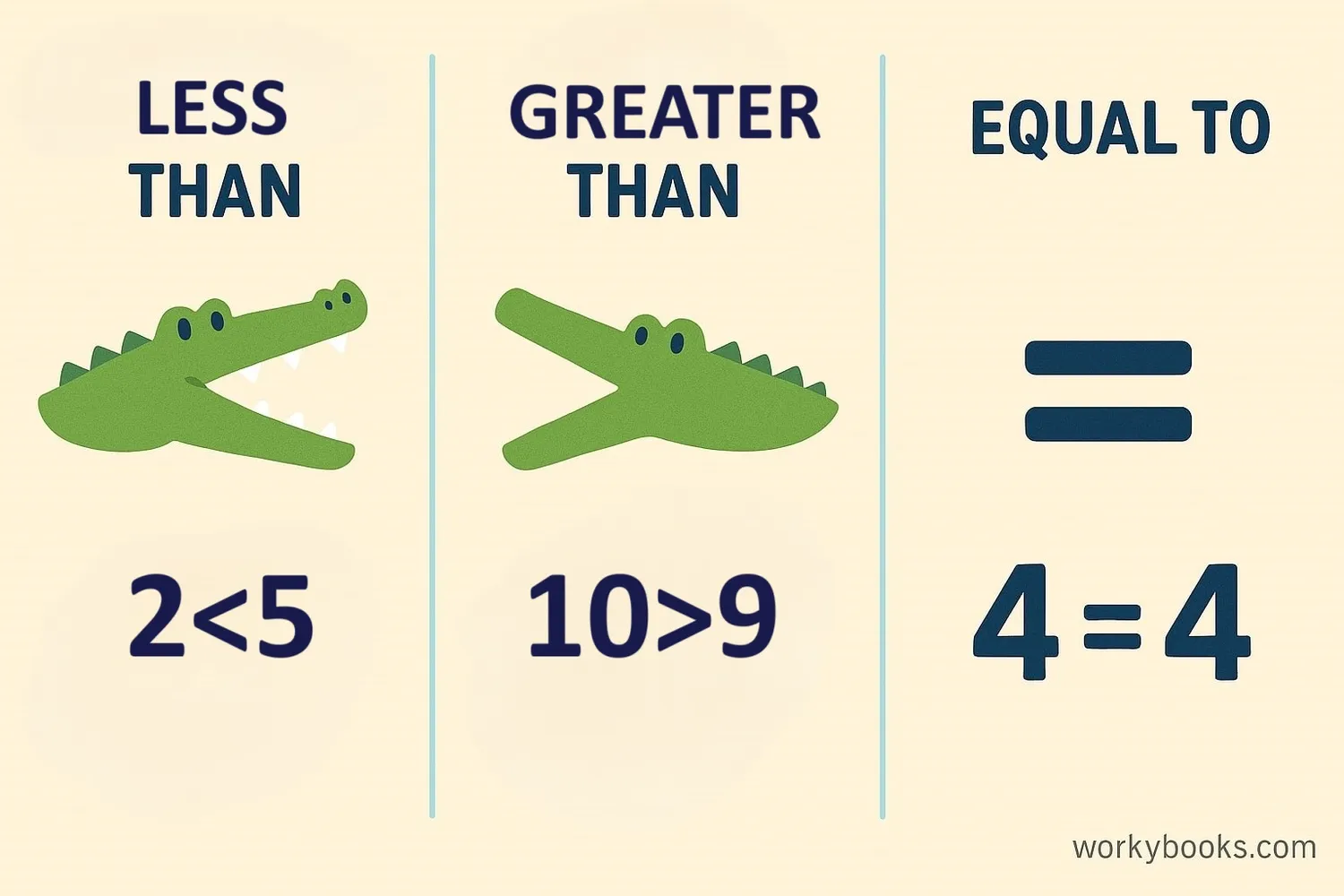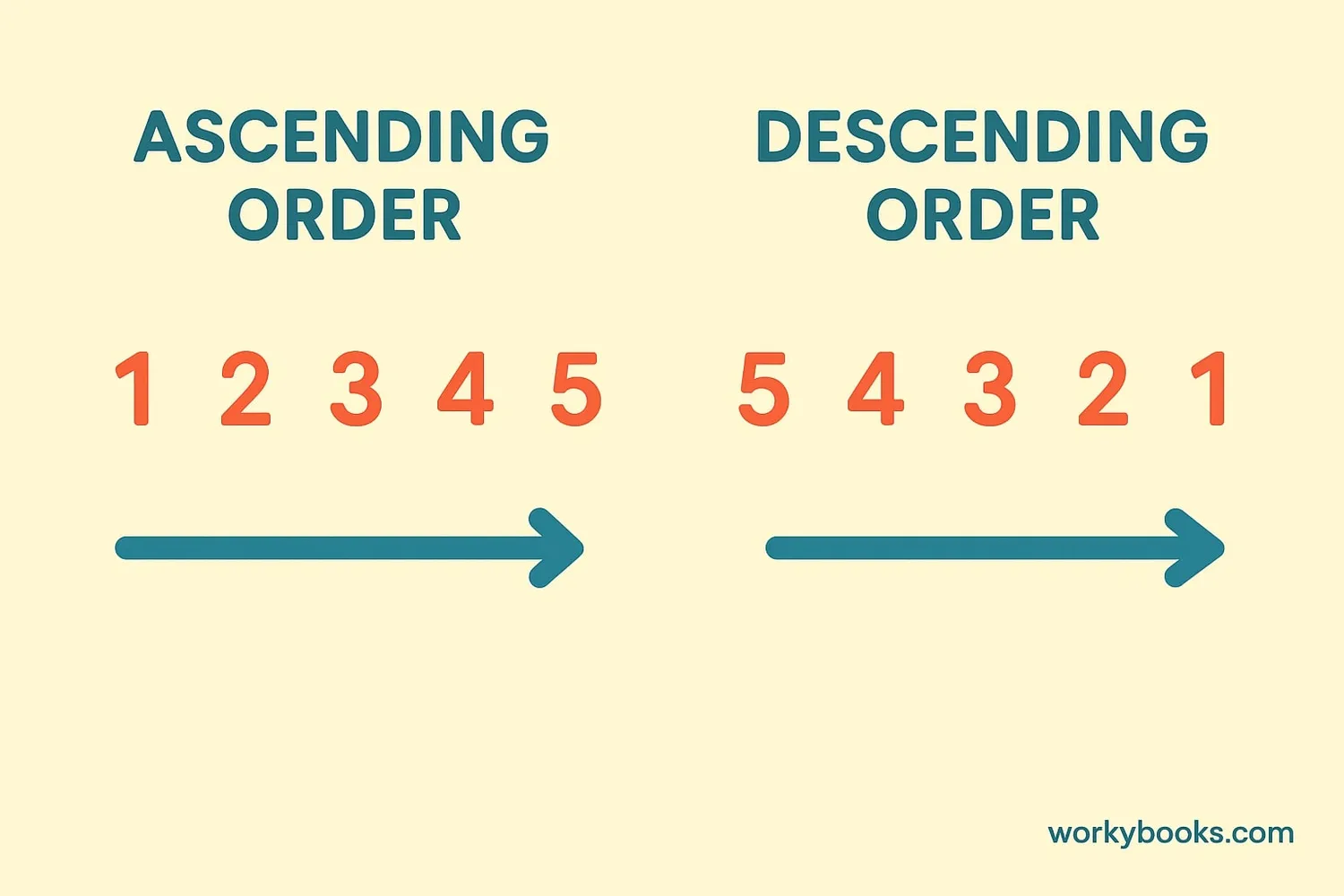Comparing and Ordering Numbers - Definition, Examples, Quiz, FAQ, Trivia
Learn to identify relationships between numbers and arrange them in order
What is Comparing Numbers?

Comparing numbers means looking at two numbers and deciding their relationship:
Greater than (>): When one number is larger than another (8 > 5)
Less than (<): When one number is smaller than another (3 < 7)
Equal to (=): When two numbers have the same value (4 = 4)
We use special symbols to show these relationships. Think of the "greater than" and "less than" symbols as alligator mouths that always open toward the larger number!
Comparison Symbols
These symbols help us write number relationships quickly
Key Concept
When comparing numbers, always look at the digits from left to right. The first digit that is different tells you which number is larger.
How to Compare Numbers
Follow these steps to compare two numbers:
Step 1: Make sure both numbers have the same number of digits. Add zeros to the front if needed (23 and 045 become 23 and 45).
Step 2: Start comparing digits from left to right.
Step 3: When you find digits that are different, the number with the larger digit is greater.
Step 4: If all digits are the same, the numbers are equal.
Let's practice with 42 and 37:
Both are 2-digit numbers. Compare tens place: 4 vs 3. Since 4 > 3, 42 > 37.
Remember
For numbers with decimals, compare the whole number part first. If they're the same, compare the decimal places one by one.
How to Order Numbers

Ordering numbers means arranging them in a sequence:
Ascending order: From smallest to largest
Descending order: From largest to smallest
Steps to order numbers:
1. Compare each number to the others
2. Find the smallest (for ascending) or largest (for descending)
3. Place it first
4. Repeat with the remaining numbers
Example: Order 15, 8, 23 in ascending order
Smallest is 8, then 15, then 23 → 8, 15, 23
Ordering Tip
When ordering decimals, line them up by the decimal point to compare place values accurately.
Real-World Examples

Comparing Heights
Sarah is 125 cm tall, Jake is 138 cm, and Maya is 121 cm. Who is tallest?
Solution: 138 > 125 > 121, so Jake is tallest.
Ordering Prices
A pencil costs $0.25, a notebook $1.50, and a backpack $15.75. Arrange from least to most expensive.
Solution: $0.25, $1.50, $15.75
Sports Scores
Team A: 78 points, Team B: 92 points, Team C: 85 points. Which team scored the least?
Solution: 78 < 85 < 92, so Team A scored least.
Birthday Months
Alex was born in March (3), Ben in July (7), Chloe in January (1). Order from earliest to latest month.
Solution: January (1), March (3), July (7)
Practice Tip
Practice comparing and ordering numbers using real objects around you - books by thickness, family members by age, or toys by size.
Practice Quiz
Test your number comparison skills with this 5-question quiz. Choose the correct answer for each question.
Frequently Asked Questions
Here are answers to common questions about comparing and ordering numbers:
Number Trivia
Discover interesting facts about numbers:
Ancient Number Systems
The ancient Babylonians used a base-60 number system around 2000 BCE. This is why we have 60 seconds in a minute and 60 minutes in an hour.
The Concept of Zero
Zero as a number was first used in India around the 5th century. Before this, number systems didn't have a symbol or concept for "nothing".
Largest Named Number
The largest named number is "googolplex" - 10 raised to the power of a googol (which is 1 followed by 100 zeros). It's so large that there isn't enough space in the universe to write it out.
Perfect Numbers
A perfect number equals the sum of its proper divisors. 6 is perfect because 1 + 2 + 3 = 6. The next perfect numbers are 28, 496, and 8128. There are only 51 known perfect numbers.




